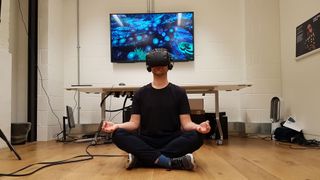HTC Vive as a meditation tool - the good, the bad, and the psychedelic
Transporting you to a world of relaxation

London isn't exactly the most Zen place to live. As I stood on the tube this morning, my face buried in the armpit of a stranger's unwashed Batman hoodie, I didn't feel particularly 'centered'.
Thankfully I was on my way to an event to use the HTC Vive VR headset as a meditation tool. The sound of strapping a screen to your face doesn't sound particularly relaxing so I was definitely curious to see if this could be more than just a marketing gimmick for a device that is struggling to find its foothold.
So far my experiences with the Vive (as awesome as they have been) have all involved raising my heart rate, not lowering it. And as fun as that is, nothing has even come close to convincing me that it's worth the hefty price tag that it comes with.
Most people escape the hustle and bustle of everyday life using their little snippets of holiday. A week by the pool, a few days on the slopes, a long weekend eating gelato and sipping red wine. But these breaks are few and far between. What if there was a way to get away on a regular basis without leaving your house?
Umm, ommmm?
There is a growing trend towards including some form of mindfulness or meditation in people's everyday lives, with top mindfulness app Headspace having now been downloaded over 6 million times according to Fortune; so it makes sense that while still in its infancy, VR would try its hand at this growing market.
VR headsets aren't quite perfect yet, so you still have light seeping in through the nose gap on the headset, and you're still very aware of the pixelation of the screen, even on the top-of-the-range Vive. But in future iterations I can imagine the screen being so good that you truly feel transported to a different world.
As for whether I felt more relaxed when I finished, it depended very much on which game I experienced.
Get daily insight, inspiration and deals in your inbox
Get the hottest deals available in your inbox plus news, reviews, opinion, analysis and more from the TechRadar team.

There was Guided Meditation VR, where you can choose your music, your setting, and the type of guided meditation you want. The voiceover was very relaxing, but the vista – as beautiful as it was – never truly felt like it was connected to the experience of the meditation. It felt like you were looking at a computer screen while being guided through a meditation.
And this is fundamentally the problem; when you’re playing an active game in VR, the graphics don’t always matter too much as you’re distracted by the action. When the primary focus is the beautiful landscape, the pixelation of the image suddenly matters a lot more.
This does mean that the most successful game of the morning was Blortasia. It’s a weird name, but it’s an appropriate one. Blortasia is definitely an odd experience.

You control how you fly around a psychedelic “art installation unconstrained by the limits of ordinary reality”. Which is a very grand way of saying ‘giant floating paint-like thing’. The shifting surfaces provide you with a seemingly endless variety of colors and patterns to look at, and the flying is incredibly satisfying. It’s the closest I’ve come to the feeling of flying you get in dreams. But the results have not been the same across the board, some people end up getting motion sickness.
One that I was seriously excited about trying was Lumen VR, a game where you can ‘grow’ a bioluminescent forest by focusing on the elements that you want to flourish. There is this feeling that I get, particularly in movie scenes with bio-luminescence (the night scene in Avatar is a good example) where I just wish I could live in that world.
While it was fun to play, I can’t say I felt any more relaxed after playing. Also, the trees that grow don’t have any leaves or flowers on them so you do end up growing a dead forest which feels more than a little sinister and wasn't the Avatar-like world I wanted it to be.

Overall I had a great morning, but it’s similar to previous experiences I’ve had with the Vive. It’s incredible that the technology exists, but it still feels like it’s a way off its potential. The cables are cumbersome (I almost garrotted myself getting out of the guided meditation experience), the screen fidelity isn’t quite good enough, and it’s still seriously expensive.
There is definitely the potential for the Vive to work as a meditation aid, just not yet.
- Check out our full review of the HTC Vive here.
Andrew London is a writer at Velocity Partners. Prior to Velocity Partners, he was a staff writer at Future plc.

